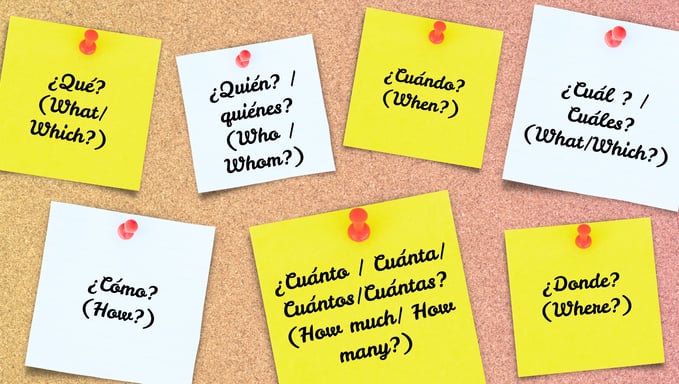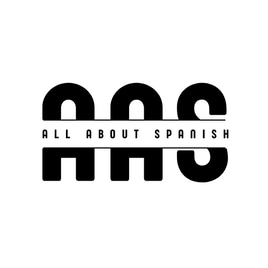START YOUR SPANISH LEARNING JOURNEY
SPANISH QUESTION WORDS -How to ask question in Spanish?
Here is a helpful guide for beginners to ask questions. In Spanish, there are 7 question words which can help you in making conversations on a daily basis. Let’s learn how to ask questions in Spanish on a daily basis through the Spanish question words.
12/20/20243 min read


Before we go on and learn the Spanish question words, let’s learn about two Spanish punctuations used in the above image.
ACCENT MARKS
In Spanish, the accent marks tell you which letter is said out loud with more emphasis and a little bit longer than the rest of the letters. Accent marks will only be seen above vowels, i.e., á, é, í, ó, and ú.
You might have noticed that all the Spanish question words have accent marks. The words that does not have accent marks will have different meaning. For example – “Qué” with accent mark means “what or which” but “que” without an accent mark means “that”.
INVERTED QUESTION MARK
In Spanish, there are two question marks used: at the beginning of the question “the inverted question mark” is used and at the end question mark is used.
It is useful to learn and use accent marks and inverted question marks throughout your Spanish learning journey. Through repetition happen language learning. Even though like English, Spanish is also spoken informally through text or online chatting. Native Spanish speakers will often leave out accent marks or even change the spelling of a word. But it is often better to learn a language as it is so that people understand you better.
1. ¿Qué? (What/Which)
Qué is used to ask about things in general or about time.
For example : If you have to ask about time, you can say “¿Qué hora es ?” – What time is it? Or Suppose you are in a store and you want to ask about a product, you can say “¿Qué es esto? – What is this?
It is easy to get confused between Qué & Cuál because they mean the same (what and which). Luckily, even if you switch them both people would still understand you.
Use Qué when there isn’t clear set of choices or for responses in general.
Use Cuál for preferences, clarification or specific things.
2. ¿Quién? / quiénes? (Who? / Whom?)
Quién and quiénes is used to ask about people. Quién is singular (to ask about a single person) whereas quiénes is plural (to ask about a group of people). These words follow number agreement which means it tells whether the noun is singular or plural.
For example : Here, partner (noun) is singular, so quién is used.
¿Quién es tu pareja? - Who is your partner?
¿Quiénes van a la fiesta? – Who’s going to the party?
3. ¿Cuándo? (When)
Cuándo is used for asking when something will happen.
For example : ¿Cuándo es la fiesta? – when is the party?
4. ¿Cuál ? / Cuáles? (What/Which)
Cuál or Cuáles is used to identify somebody or something.
For example:
¿Cuál es tu pelicula favorita? – What is your favorite movie?
¿Cuál es tu nombre? – What is your name?
¿Cuáles son tus pasatiempos? – What are your hobbies?
5. ¿Cómo? (How)
Cómo is used to ask someone how they are, their name or how to do something.
For example:
¿Cómo te llamas? – What’s your name?
¿Cómo estás? – How are you?
¿Cómo funciona esto? – How does this work?
6. ¿Cuánto / Cuánta/ Cuántos/Cuántas? (How much / How many)
Cuánto (masculine singular) and Cuánta (feminine singular) is used for uncountable things (how much).
Cuántos (masculine plural) and Cuántas (feminine plural) is used for countable things (how many).
For example:
¿Cuánto tiempo necesita arsh? – How much time does arsh need?
¿Cuánta verduras necesitas? – How much vegetables do you need?
¿Cuántos años tiene aadya? – How old is aadya?
¿Cuántos libros tienes? – How many books do you have?
¿Cuántas personas hay en la sala? – How many people are there in the drawing room?
7. ¿Dónde? (Where)
Dónde is used to ask about the location or where something or someone is.
For example:
¿Dónde está el estación de metro? – Where is the metro station?
¿Dónde vive Arshita ? – Where does arshita live?
¿De donde es Aarvi? - Where is Aarvi from?
CONCLUSION
Spanish question words usually appear as the first or second word of the question. Sometimes they appear after prepositions like con, de, a, etc. For example: ¿De dónde eres? Where are you from?
Now that you’ve learnt the 7 question words in Spanish, it is time you start your conversations with classmate, colleagues and see your conversational progress.
